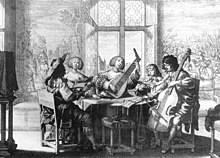Music history of France
France has a rich music history that was already prominent in Europe as far back as the 10th century.
Medieval music
Some of the earliest manuscripts with
Saint Martial school
The Saint Martial school, named after the Abbey of Saint Martial around which it was centered, was an important group in the development of early French music. The school created various forms of music based on poetry. These forms of music were often organa consisting of elaborate proses and tropes. Important composers from this school include Roger de Chabannes and his nephew and student Adémar de Chabannes. The manuscripts written by these two became very popular and included early uses of troper-prosers and sequentiaries.[1] The duo also pioneered a new form of notation for their work that collected new forms of liturgical poetry.[2] While polyphony was not invented at the Saint Martial school, the group developed it extensively and brought it into common use. All of these contributions made the Saint Martial school an important precursor to the later Notre-Dame school.
Notre-Dame school
The Notre-Dame school was a group of composers who used a style of polyphonic organum that flourished at Paris'
Motet
The motet, a lyrical piece of music in several parts,
Troubadours
In the 12th century, traveling noblemen and musicians called troubadours began traveling southern France. Inspired by the
Ars nova and ars subtilior
Two of the major developments in music in the 14th century occurred in France. The first was
The other important development was the extremely complex and sophisticated art of secular song which flourished in Avignon at the very end of the 14th century, ars subtilior. Ars subtilior immediately followed ars nova, and as the Latin definition suggests, this style was subtler than the earlier works. Ars subtilior was also even more complex, making it difficult to sing and most popular among music specialists.
Renaissance music
The move of the center of musical activity from Paris to Burgundy defines the beginning of the musical Renaissance in France. The political instability under weak kings and continued dismemberment and acquisition of territory by the English during the Hundred Years' War all contributed to moving musicians east.
French musical domination of Europe ended during the Renaissance, and
Motet
The motet was known from the Medieval era, but after about 1463, it evolved into an utterly distinct form. The cascading, passing chords created by the interplay between multiple voices and the absence of a strong or obvious beat are the features that distinguish the medieval vocal styles from those of the Renaissance. Instead, the Renaissance motet was a short polyphonic musical setting in imitative counterpoint, for chorus, of a religious text not specifically connected to the liturgy of a given day, and therefore suitable for use in any service. The cantus firmus was extended during the Renaissance period, making the motet suitable for use in a larger variety of services.[4] The texts of antiphons were frequently used as motet texts. This is the sort of composition that is most familiarly called by the name of "motet," and the Renaissance period marked the flowering of the form.
Chanson
The chanson encompasses a wide array of forms and styles of secular song, through a period of almost three hundred years. The first important composer of chansons was
Burgundian School
Composers who worked at the courts of the Dukes of Burgundy are known collectively as the
Baroque music

With the arrival of
The
The Baroque period saw also a flourishing of "Grand Motet and Petit Motet" music. Influential composers included, Henri Dumont, Jean Gilles, Marc-Antoine Charpentier, Henri Desmarest, Michel Richard Delalande, André Campra, and Jean-Joseph de Mondonville.
Air de cour
In the late Renaissance and early Baroque period, approximately from 1570 to 1650 and peaking from 1610 and 1635, a type of popular secular vocal music called air de cour spread throughout France. Though airs de cour originally used only one voice with lute accompaniment,[8] they grew to incorporate four to five voices by the end of the 16th century. Halfway through the 17th century, they switched back again to a single voice.
See also
References
- OCLC 82037233.
- ISBN 978-1-139-46016-3.
- ISBN 978-0-520-21081-3.
- ^ )
- )
- ^ Lorde, Suzanne (2008). Music in the Middle Ages. London: Greenwood Press.
- ISBN 978-0-203-34487-3.
- OCLC 53469410.
